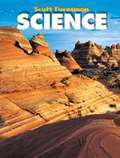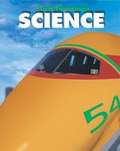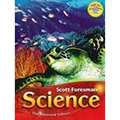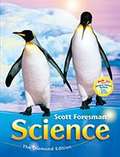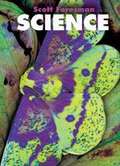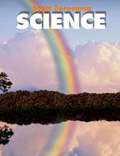- Table View
- List View
Scott Foresman Science
by Timothy Cooney Karen L. Ostlund Michael Anthony Dispezio Barbara K. Foots Kate Boehm Nyquist Angie L. MatamorosScientists try to solve many problems. Scientists study problems in different ways, but they all use scientific methods to guide their work. Scientific methods are organized ways of finding answers and solving problems. Scientific methods include the steps shown on these pages. The order of the steps or the number of steps used may change. You can use these steps to organize your own scientific inquiries.
Scott Foresman Science
by Timothy Cooney Karen L. Ostlund Michael Anthony Dispezio Barbara K. Foots Kate Boehm Nyquist Angie L. MatamorosScientists try to solve many problems. Scientists study problems In different ways, but they all use scientific methods to guide their work. Scientific methods are organized ways of finding answers and solving problems. Scientific methods include the steps shown on these pages. The order of the steps or the number of steps used may change. You can use these steps to organize your own scientific inquiries.
Scott Foresman Science
by Timothy Cooney Michael Anthony Dispezio Barbara K. FootsScience for Grades 1-6 are organized into four units--Life, Physical, Earth, and Human Body sciences.
Scott Foresman Science (New Jersey)
by Scott ForesmanScience: See Learning in a Whole New Light, New Jersey Edition
Scott Foresman Science (Arkansas)
by Jim Cummins Timothy Cooney James Flood Barbara Kay Foots M. Jenice Goldston Shirley Gholston Key Diane Lapp Sheryl A. Mercier Karen L. Ostlund Nancy Romance William Tate Kathryn C. Thornton Leon Ukens Steve WeinbergHardbound Pupil Editions for Grades 1-6 are organized into four units-Life, Physical, Earth, and Human Body sciences. An age-appropriate workbook is available for Kindergarten students.
Scott Foresman Science (Arkansas)
by Jim Cummins Timothy Cooney James Flood Barbara Kay Foots M. Jenice Goldston Shirley Gholston Key Diane Lapp Sheryl A. Mercier Karen L. Ostlund Nancy Romance William Tate Kathryn C. Thornton Leon Ukens Steve WeinbergScott Foresman Science ( 2006) components for Grade 6.
Scott Foresman Science (Diamond Edition)
by Jim Cummins Timothy Cooney James Flood Barbara Kay Foots M. Jenice Goldston Shirley Gholston Key Diane Lapp Sheryl A. Mercier Karen L. Ostlund Nancy Romance William Tate Kathryn C. Thornton Leon Ukens Steve WeinbergHelp students build a strong science foundation and develop a full understanding of the inquiry process.
Scott Foresman Science (Grade #5)
by Timothy Cooney Barbara Kay Foots Karen L. Ostlund Michael Anthony Dispezio Kate Boehm Nyquist Angie L. MatamorosScience textbook for 5th grade students.
Scott Foresman Science (Grade #5)
by Timothy Cooney Karen L. Ostlund Michael Anthony Dispezio Barbara K. Foots Kate Boehm Nyquist Angie L. MatamorosHelp students build a strong science foundation and develop a full understanding of the inquiry process.
Scott Foresman Science (Grade #6)
by Timothy Cooney Karen L. Ostlund Michael Anthony Dispezio Barbara K. Foots Kate Boehm Nyquist Angie L. MatamorosHelp students build a strong science foundation and develop a full understanding of the inquiry process.
Scott Foresman Science (Grade #6)
by Timothy Cooney Michael Anthony Dispezio Barbara K. Foots Angie L. MatamorosScience books for Grades 1-6 are organized into four units--Life, Physical, Earth, and Human Body sciences.
Scott Foresman Science (Grade 1, Texas edition)
by Timothy Cooney Michael Anthony Dispezio Barbara K. Foots Angie L. MatamorosScientists use scientific methods to find answers to questions. Scientific methods have the steps shown on these pages. Scientists sometimes use the steps in different order. You can use these steps for your own science inquiries.
Scott Foresman Science (Grade 2, California edition)
by Scott ForesmanThis Scott Foresman California Science deals with Physical Sciences Life Sciences Earth Sciences, etc. supported by a lot of illuminating illustrations for an enjoyable reading.
Scott Foresman Science (Grade 3, Texas edition)
by Timothy Cooney Michael Anthony Dispezio Barbara K. Foots Angie L. MatamorosScientists try to solve many problems. Scientists study problems in different ways, but they all use scientific methods to guide their work. Scientific methods are organized ways of finding answers and solving problems.
Scott Foresman Science (Grade 4, New York Edition)
by Jim Cummins Timothy Cooney James Flood Barbara Kay Foots M. Jenice GoldstonThis book broadly covers life science, earth science, physical science, space and technology.
Scott Foresman Science (Grade 4, Texas edition)
by Scott ForesmanThis book for grade 4 is organized into four units-Life, Physical, Earth, and Human Body sciences containing a lot of useful educational materials for easy understanding of the subject.
Scott Foresman Science (Grade 6, The Diamond Edition)
by Jim Cummins Timothy Cooney James Flood Barbara Kay Foots M. Jenice Goldston Shirley Gholston Key Diane Lapp Sheryl A. Mercier Karen L. Ostlund Nancy Romance William Tate Kathryn C. Thornton Leon Ukens Steve WeinbergThis book focuses on Life science, Earth science, Physical science etc.
Scott Foresman Science (Illinois, Diamond Edition)
by Jim Cummins Timothy Cooney James Flood Barbara Kay Foots M. Jenice Goldston Shirley Gholston Key Diane Lapp Sheryl A. Mercier Karen L. Ostlund Nancy Romance William Tate Kathryn C. Thornton Leon Ukens Steve WeinbergThis book is about Life Science, Earth Science, Physical Science, Space and Technology in Illinois, the fifth most populous state of USA.
Scott Foresman Science (New York, Diamond Edition)
by Pearson Scott ForesmanThis edition deals with Life Science in New York, Earth Science in New York and Physical Science in New York.
Scott Foresman Science (Oklahoma Edition)
by Pearson EducationThis textbook on science contains lessons comprised in four units viz., Life Science, Earth Science, Physical Science, and Space and Technology.
Scott Foresman Science (See Learning in a Whole New Light)
by Jim Cummins Timothy Cooney James Flood M. Jenice Goldston Shirley Gholston Key Diane Lapp Sheryl A. Mercier Karen L. Ostlund Nancy Romance William Tate Kathryn C. Thornton Leon Ukens Steve Weinberg Barabara Kay FootsScientists use scientific methods as they work. Scientific methods are organized ways to answer questions and solve problems. Scientific methods include the steps shown here. Scientists might not use all the steps. They might not use the steps in this order. You will use scientific methods when you do the Full Inquiry activity at the end of each unit. You also will use scientific methods when you do Science Fair Projects.
Scott Foresman Science (South Carolina)
by Jim Cummins Timothy Cooney James Flood Barbara Kay Foots M. Jenice Goldston Shirley Gholston Key Diane Lapp Karen L. Ostlund Nancy Romance William Tate Kathryn C. Thornton Sheryl MercierGrade 3 Science textbook
Scott Foresman Science (South Carolina)
by Jim Cummins Timothy Cooney James Flood Barbara Kay Foots M. Jenice Goldston Shirley Gholston Key Diane Lapp Karen L. Ostlund Nancy Romance William Tate Kathryn C. Thornton Sheryl MercierHardbound Pupil Editions for Grades 1-6 are organized into four units-Life, Physical, Earth, and Human Body sciences. An age-appropriate workbook is available for Kindergarten students.

